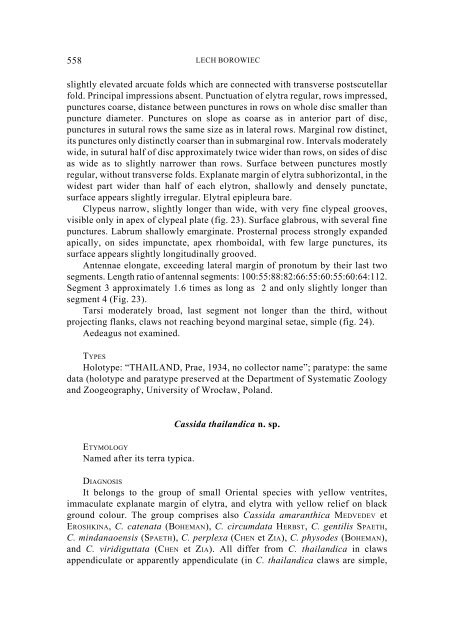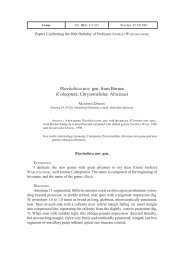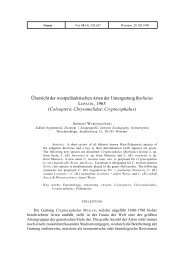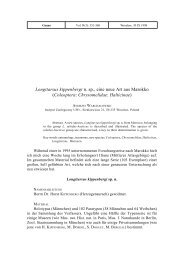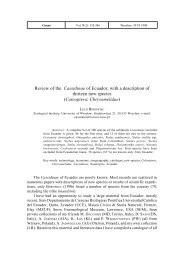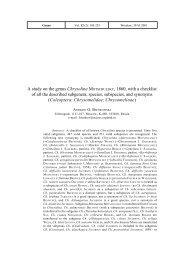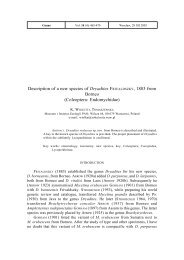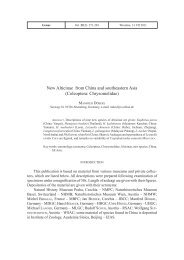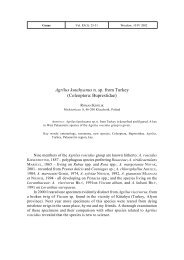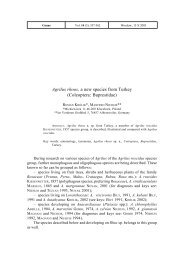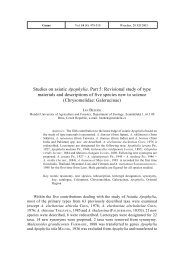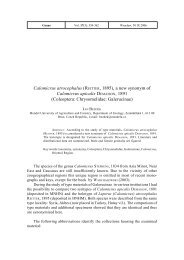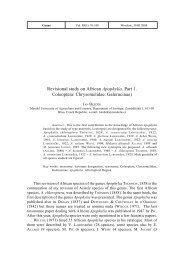New records of Asian and Australopapuan Cassidinae, with a ...
New records of Asian and Australopapuan Cassidinae, with a ...
New records of Asian and Australopapuan Cassidinae, with a ...
Create successful ePaper yourself
Turn your PDF publications into a flip-book with our unique Google optimized e-Paper software.
558<br />
LECH BOROWIEC<br />
slightly elevated arcuate folds which are connected <strong>with</strong> transverse postscutellar<br />
fold. Principal impressions absent. Punctuation <strong>of</strong> elytra regular, rows impressed,<br />
punctures coarse, distance between punctures in rows on whole disc smaller than<br />
puncture diameter. Punctures on slope as coarse as in anterior part <strong>of</strong> disc,<br />
punctures in sutural rows the same size as in lateral rows. Marginal row distinct,<br />
its punctures only distinctly coarser than in submarginal row. Intervals moderately<br />
wide, in sutural half <strong>of</strong> disc approximately twice wider than rows, on sides <strong>of</strong> disc<br />
as wide as to slightly narrower than rows. Surface between punctures mostly<br />
regular, <strong>with</strong>out transverse folds. Explanate margin <strong>of</strong> elytra subhorizontal, in the<br />
widest part wider than half <strong>of</strong> each elytron, shallowly <strong>and</strong> densely punctate,<br />
surface appears slightly irregular. Elytral epipleura bare.<br />
Clypeus narrow, slightly longer than wide, <strong>with</strong> very fine clypeal grooves,<br />
visible only in apex <strong>of</strong> clypeal plate (fig. 23). Surface glabrous, <strong>with</strong> several fine<br />
punctures. Labrum shallowly emarginate. Prosternal process strongly exp<strong>and</strong>ed<br />
apically, on sides impunctate, apex rhomboidal, <strong>with</strong> few large punctures, its<br />
surface appears slightly longitudinally grooved.<br />
Antennae elongate, exceeding lateral margin <strong>of</strong> pronotum by their last two<br />
segments. Length ratio <strong>of</strong> antennal segments: 100:55:88:82:66:55:60:55:60:64:112.<br />
Segment 3 approximately 1.6 times as long as 2 <strong>and</strong> only slightly longer than<br />
segment 4 (Fig. 23).<br />
Tarsi moderately broad, last segment not longer than the third, <strong>with</strong>out<br />
projecting flanks, claws not reaching beyond marginal setae, simple (fig. 24).<br />
Aedeagus not examined.<br />
TYPES<br />
Holotype: “THAILAND, Prae, 1934, no collector name”; paratype: the same<br />
data (holotype <strong>and</strong> paratype preserved at the Department <strong>of</strong> Systematic Zoology<br />
<strong>and</strong> Zoogeography, University <strong>of</strong> Wroc³aw, Pol<strong>and</strong>.<br />
ETYMOLOGY<br />
Named after its terra typica.<br />
Cassida thail<strong>and</strong>ica n. sp.<br />
DIAGNOSIS<br />
It belongs to the group <strong>of</strong> small Oriental species <strong>with</strong> yellow ventrites,<br />
immaculate explanate margin <strong>of</strong> elytra, <strong>and</strong> elytra <strong>with</strong> yellow relief on black<br />
ground colour. The group comprises also Cassida amaranthica MEDVEDEV et<br />
EROSHKINA, C. catenata (BOHEMAN), C. circumdata HERBST, C. gentilis SPAETH,<br />
C. mindanaoensis (SPAETH), C. perplexa (CHEN et ZIA), C. physodes (BOHEMAN),<br />
<strong>and</strong> C. viridiguttata (CHEN et ZIA). All differ from C. thail<strong>and</strong>ica in claws<br />
appendiculate or apparently appendiculate (in C. thail<strong>and</strong>ica claws are simple,


